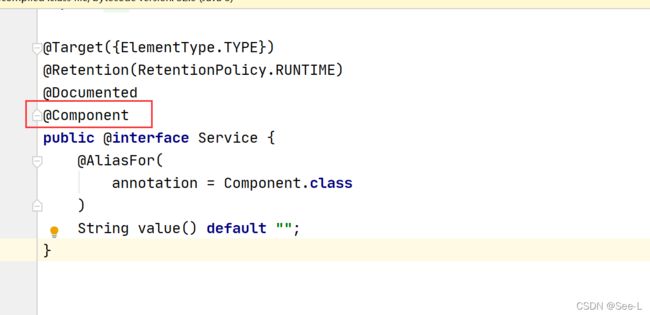Spring~用注解储存bean(类注解、方法注解)
文章目录
- 如何更简单的储存spring
- 配置扫描路径
- 类注解介绍:
-
- 类注解之间的关系
- 举例:
-
- @Controller
- @Servie
- @Repository
- @Component
- 注意点:
- 方法注解
前面我们了解到,如果想要将一个对象储存到spring中,需要以下几个步骤:
1.创建
maven文件
2.在
pom.xml中引入spring依赖包
3.创建一个配置xml文件,存放bean对象
4.在测试类中,通过上下文对象来获取bean对象进行调用
每次想要存入bean对象时,都需要到配置的xml文件中进行修改,是非常麻烦的。为了使存储和读取对象更简单,能直接在代码中进行操作,spring提供了注解的方式来解决这个问题。
Spring的核心是IOC,就是将bean对象初始化并加载到容器中,将bean加载到容器中,有两种方式:配置XML文件或者使用Spring注解。这里介绍的就是后者,操作简单,方便管理,可以提高开发效率。
如何更简单的储存spring
1.创建一个maven文件
2.添加spring核心包
3.配置xml文件,在文件中配置扫描路径
4.在代码中直接使用注解读取和储存
以前需要在储存一个bean对象时,需要手动的在配置文件中创建bean,这里直接配置一个扫描路径,将所有需要储存的对象放到该目录下,当我们用在代码中用注解标识该类时,spring会自动的扫描这个路径,将对应的对象自动添加到spring框架中。
配置扫描路径
在使用注解之前,我们需要配置扫描路径,将所有的对象直接放在该路径下,spring会自动扫描对应的bean并添加到框架中。
创建一个xml配置文件:
<beans xmlns="http://www.springframework.org/schema/beans"
xmlns:xsi="http://www.w3.org/2001/XMLSchema-instance"
xmlns:content="http://www.springframework.org/schema/context"
xsi:schemaLocation="http://www.springframework.org/schema/beans http://www.springframework.org/schema/beans/spring-beans.xsd http://www.springframework.org/schema/context https://www.springframework.org/schema/context/spring-context.xsd">
<content:component-scan base-package="model">content:component-scan>
beans>
这里的base-package属性中写入对象存放的路径,这里是放在了model包下。

配置完成后,就可以使用注解了。
注解很多的分类,类注解、方法注解,后面还会介绍的事务模块注解、springMVC注解等等,从广义上可以分为两类:一类是注册Bean,一类是使用Bean.这里先了解一些简单常用的注解,这些注解都可以划分到第一大类中–注册Bean.
类注解:@Configuration、@Controller、@Servie、@Repository、@Component 。
方法注解:@Bean.
类注解介绍:
问:Spring是如何知道需要将哪些Javal类注册到容器中?
答:使用配置文件或者注解的方式来标识需要处理的Java类。
类注解也可以称为组件类注解,即把一些类当做组件进行使用。
@Component:标识一个普通的bean类
@Controller:标识一个控制器组件类,一般用在控制前后端交互的类中,进行数据校验。
@Service :标识一个业务逻辑组件类,进行数据的组装。
@Repository:标识一个DAO组件类,即数据访问层组件,用来访问数据,像连接数据库,进行增删查改操作。
@Configuration:标识一个类作为加载spring的配置类,这个类的作用是配置spring并启动spring容器。
类注解之间的关系

@Component、@Controller、@Service、@Repository这四个注解实际上一类注解,功能相同,用法相同,区别在于标识当前类是什么组件类型,方便程序员快速了解当前类的作用。
@Component可以替代@Controller、@Service、@Repository,因为这三个注解是被@Component标注的,从逻辑上可以理解为是Component的子类。
如下图:
Controller、Service、Repository三者都是被Component标注。




举例:
@Controller
UserController类作为bean:
package model;
import org.springframework.stereotype.Controller;
@Controller //将当前类储存到Spring,标识此类为控制交互层
public class UserController {
public void firstUseController(String name){
System.out.println("Hi,Controller:"+name);
}
}
在测试类中使用:
import model.HelloApplicationContext;
import model.UserController;
import org.springframework.context.ApplicationContext;
import org.springframework.context.support.ClassPathXmlApplicationContext;
public class App {
public static void main(String[] args) {
ApplicationContext context=new ClassPathXmlApplicationContext("spring.xml");
UserController userController=(UserController) context.getBean("userController");
userController.firstUseController("Hello!");
}
}
输出:
Hi,Controller:Hello!
@Servie
UserService作为bean:
package model;
import org.springframework.stereotype.Service;
@Service //将此类储存到String中,这个类中可以进行数据组装
public class UserService {
public void firstUseService(String name){
System.out.println("Hi,Service:"+name);
}
}
在测试类中使用:
import model.HelloApplicationContext;
import model.UserController;
import model.UserService;
import org.springframework.context.ApplicationContext;
import org.springframework.context.support.ClassPathXmlApplicationContext;
public class App {
public static void main(String[] args) {
ApplicationContext context=new ClassPathXmlApplicationContext("spring.xml");
UserService userService=(UserService) context.getBean("userService");
userService.firstUseService("Hello!");
}
}
输出:
Hi,Service:Hello!
@Repository
package model;
import org.springframework.stereotype.Repository;
@Repository//将此类储存到String中,标识此类是数据访问组件
public class UserRepository {
public void firstUseRepository(String name){
System.out.println("Hi,Repository:"+name);
}
}
在测试类中使用:
import model.HelloApplicationContext;
import model.UserController;
import model.UserRepository;
import model.UserService;
import org.springframework.context.ApplicationContext;
import org.springframework.context.support.ClassPathXmlApplicationContext;
public class App {
public static void main(String[] args) {
ApplicationContext context=new ClassPathXmlApplicationContext("spring.xml");
UserRepository userRepository=(UserRepository) context.getBean("userRepository");
userRepository.firstUseRepository("Hello!");
}
}
输出:
Hi,Repository:Hello!
@Component
package model;
import org.springframework.stereotype.Component;
@Component
public class UserComponent {
public void firstUseComponent(String name){
System.out.println("Hi,Component:"+name);
}
}
在测试类中使用:
import model.*;
import org.springframework.context.ApplicationContext;
import org.springframework.context.support.ClassPathXmlApplicationContext;
public class App {
public static void main(String[] args) {
ApplicationContext context=new ClassPathXmlApplicationContext("spring.xml");
UserComponent userComponent=(UserComponent) context.getBean("userComponent");
userComponent.firstUseComponent("Hello!");
}
}
输出:
Hi,Component:Hello!
注意点:
- 被注解的Java类会被当做Bean对象储存到spring中,这个对象的默认名称是类名的首字母小写,其余部分不变。

- @Service也可以自定义Bean名称,但是必须唯一。
- 尽量使用对应的组件注解来替换@Component,因为未来的Spring版本中,@Controller,@Service,@Repository可能会携带更多语义。
方法注解
方法注解:@Bean.注解在方法前,作用是让这个方法产生一个Bean对象,然后这个Bean对象交给容器进行管理。这个方法只会spring只会调用一次,然后将这个对象放入自己的IOC容器中。
package model;
import org.springframework.context.annotation.Bean;
import org.springframework.stereotype.Component;
@Component
public class UserBean {
private String name;
private int Id;
private int age;
public void setName(String name) {
this.name = name;
}
public void setId(int id) {
Id = id;
}
public void setAge(int age) {
this.age = age;
}
@Override
public String toString() {
return "UserBean{" +
"name='" + name + '\'' +
", Id=" + Id +
", age=" + age +
'}';
}
@Bean
public UserBean users(){
UserBean user=new UserBean();
user.setName("张三");
user.setId(01);
user.setAge(18);
return user;
}
}
在测试类中运行:
import model.*;
import org.springframework.context.ApplicationContext;
import org.springframework.context.support.ClassPathXmlApplicationContext;
import javax.jws.soap.SOAPBinding;
public class App {
public static void main(String[] args) {
//1.获取上下文对象
ApplicationContext context=new ClassPathXmlApplicationContext("spring.xml");
//2.获取spring中存入的bean对象,id默认是类名首字母小写,其余不变
UserBean user=(UserBean)context.getBean("users");
//3.调用方法
System.out.println(user.toString());
}
}
运行结果如下:
UserBean{name='张三', Id=1, age=18}
注意:Spring在默认情况下是类扫描,如果使用方法注解@Bean,需要搭配类注解@Component或者@Configuration一起使用,否则spring无法扫描到这个方法,就不能将方法返回对象储存到spring中。
重命名
在使用@Bean时,我们可以对方法进行重命名,可以同时为该方法创建多个名字:
@Bean(name={"u1","us1"})
public UserBean users(){
UserBean user=new UserBean();
user.setName("张三");
user.setId(01);
user.setAge(18);
return user;
}
